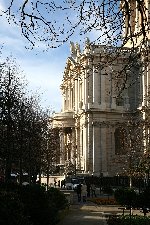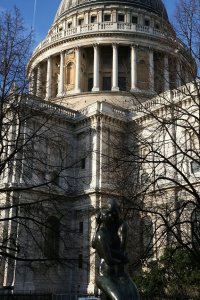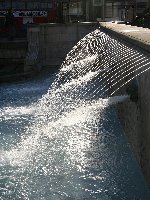St Paul's Cathedral dominates the City of London's skyline. Strict planning laws ensure that this remains the case, even in these days of tower blocks and skyscrapers.
The cathedral was built by Sir Christopher Wren between 1675 and 1710, to replace Old St Paul's which was destroyed in the Great Fire of London in 1666. There was a good deal of haggling over the design and it was Wren's third design that was commissioned, although he made changes as construction work progressed. At the same time as he built the cathedral Wren was also reconstructing fifty churches that were also destroyed in the fire, a feat unique in history. The building is a masterpiece of engineering, eschewing the conventional tower or spire for the dome that gives St Paul's its unique profile. It is truly massive - 515 ft long, 242 ft across at its widest point, and 365 ft high.
Below the church is the crypt, the largest in Europe and containing some 200 memorials including that of Wren himself, who died in 1723. "If you seek his monument," says the inscription on his tombstone, "look around you."
View east towards the Barbican and Tower 42; view south to the Millennium Bridge and Bankside
You don't have to be a religious person or have any particular interest in church architecture to appreciate St Paul's. Interior photography is banned, unfortunately, but the cathedral offers one particular advantage to the photographer - it is the only high viewpoint in London accessible to the public, save for the London Eye observation wheel. To reach the galleries you first make your way up an enormous spiral staircase to the Whispering Gallery, the base of the internal dome, 259 steps from ground level and 99 ft above the floor. The gallery is so called due the the peculiar acoustics that allow a whisper spoken on one side of the gallery to be heard on the opposite side.
It's not generally appreciated that the internal and external domes of St Paul's are quite different - the internal structure sits within the cylinder visible from outside, and the external dome is actually a relatively lightweight weather shield that is cunningly designed with gaps in its upper surface to admit daylight to the interior. If you take another spiral staircase up from the Whispering Gallery you reach the Stone Gallery, 378 steps and 173 ft above ground level, running around the base of this external dome on the exterior. The views from here are excellent but they are excelled by those from the Golden Gallery. This encircles the base of the "ball and lantern" tower atop the external dome, which is supported internally by a brick cone structure hidden between the internal and external domes. It is reached by a rather giddy iron staircase that climbs the wall of this supporting cone. It's 530 steps and 280ft above ground level, and can admit only a dozen people at a time without being impossibly crowded. Choose a quiet day if you go. And remember, there are no lifts - and no way down once you commit yourself to each section of the ascent, for the descent stairways are separate. A further stairway, ascending into the ball and cross, is no longer open to the public.
Views from the external galleries; west along the Thames, west-northwest over Bloomsbury and Marylebone, and northeastwards towards the Barbican and Moorgate








![]() St
Paul's Cathedral official website
St
Paul's Cathedral official website
![]() Map
of St Paul's Cathedral and aerial photos by Streetmap.co.uk
Map
of St Paul's Cathedral and aerial photos by Streetmap.co.uk
![]() Back to City of London index page
Back to City of London index page
This page last updated 23rd January 2008
![]()